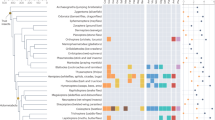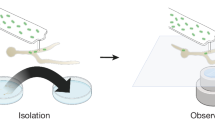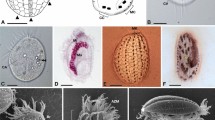Abstract
We investigated seed bugs of the genus Nysius (Insecta: Hemiptera: Lygaeidae) for their symbiotic bacteria. From all the samples representing 4 species, 18 populations and 281 individuals, specific bacterial 16S rRNA gene sequences were consistently identified, which formed a distinct clade in the Gammaproteobacteria. In situ hybridization showed that the bacterium was endocellularly localized in a pair of large bacteriomes that were amorphous in shape, deep red in color, and in association with gonads. In the ovary of adult females, the endosymbiont was also localized in the ‘infection zone’ in the middle of each germarium and in the ‘symbiont ball’ at the anterior pole of each oocyte, indicating vertical transmission of the endosymbiont through the ovarial passage. Phylogenetic analyses based on bacterial 16S rRNA, groEL and gyrB genes consistently supported a coherent monophyly of the Nysius endosymbionts. The possibility of a sister relationship to ‘Candidatus Kleidoceria schneideri’, the bacteriome-associated endosymbiont of a lygaeid bug Kleidocerys resedae, was statistically rejected, indicating independent evolutionary origins of the endosymbionts in the Lygaeidae. The endosymbiont genes consistently exhibited AT-biased nucleotide compositions and accelerated rates of molecular evolution, and the endosymbiont genome was only 0.6 Mb in size. The endosymbiont phylogeny was congruent with the host insect phylogeny, suggesting strict vertical transmission and host–symbiont co-speciation over evolutionary time. Based on these results, we discuss the evolution of bacteriomes and endosymbionts in the Heteroptera, most members of which are associated with gut symbiotic bacteria. The designation ‘Candidatus Schneideria nysicola’ is proposed for the endosymbiont clade.
Similar content being viewed by others
Log in or create a free account to read this content
Gain free access to this article, as well as selected content from this journal and more on nature.com
or
References
Abe Y, Mishiro K, Takanashi M . (1995). Symbiont of brown-winged green bug, Plautia stali Scott. Jpn J Appl Entomol Zool 39: 109–115.
Akman L, Yamashita A, Watanabe H, Oshima K, Shiba T, Hattori M et al. (2002). Genome sequence of the endocellular obligate symbiont of tsetse flies, Wigglesworthia glossinidia. Nat Genet 32: 402–407.
Baumann P . (2005). Biology of bacteriocyte-associated endosymbionts of plant sap-sucking insects. Annu Rev Microbiol 59: 155–189.
Blattner FR, Plunkett III G, Bloch CA, Perna NT, Burland V, Riley M et al. (1997). The complete genome sequence of Escherichia coli K-12. Science 277: 1453–1474.
Bourtzis K, Miller T . (2003). Insect Symbiosis. CRC Press: Boca Raton.
Braendle C, Miura T, Bickel R, Shingleton AW, Kambhampati S, Stern DL . (2003). Developmental origin and evolution of bacteriocytes in the aphid–Buchnera symbiosis. PLoS Biol 1: e21.
Buchner P . (1965). Endosymbiosis of Animals with Plant Microorganisms. Interscience: New York, USA.
Chen X, Li S, Aksoy S . (1999). Concordant evolution of a symbiont with its host insect species: molecular phylogeny of genus Glossina and its bacteriome-associated endosymbiont, Wigglesworthia glossinidia. J Mol Evol 48: 49–58.
Conord C, Despres L, Vallier A, Balmand S, Miquel C, Zundel S et al. (2008). Long-term evolutionary stability of bacterial endosymbiosis in Curculionoidea: additional evidence of symbiont replacement in the Dryophthoridae family. Mol Biol Evol 25: 859–868.
Douglas AE . (1998). Nutritional interactions in insect-microbial symbioses: aphids and their symbiotic bacteria Buchnera. Annu Rev Entomol 43: 17–37.
Frydman HM, Li JM, Robson DN, Wieschaus E . (2006). Somatic stem cell niche tropism in Wolbachia. Nature 441: 509–512.
Fukatsu T . (1999). Acetone preservation: a practical technique for molecular analysis. Mol Ecol 8: 1935–1945.
Fukatsu T, Aoki S, Kurosu U, Ishikawa H . (1994). Phylogeny of Cerataphidini aphids revealed by their symbiotic microorganisms and basic structure of their galls: implications for host-symbiont coevolution and evolution of sterile soldier castes. Zool Sci 11: 613–623.
Fukatsu T, Hosokawa T . (2002). Capsule-transmitted gut symbiotic bacterium of the Japanese common plataspid stinkbug, Megacopta punctatissima. Appl Environ Microbiol 68: 389–396.
Fukatsu T, Nikoh N . (2000). Endosymbiotic microbiota of the bamboo pseudococcid Antonina crawii (Insecta, Homoptera). Appl Environ Microbiol 66: 643–650.
Fukatsu T, Nikoh N, Kawai R, Koga R . (2000). The secondary endosymbiotic bacterium of the pea aphid Acyrthosiphon pisum (Insecta: Homoptera). Appl Environ Microbiol 66: 2748–2758.
Futahashi R, Tanaka K, Matsuura Y, Tanahashi M, Kikuchi Y, Fukatsu T . (2011). Laccase2 is required for cuticular pigmentation in stinkbugs. Insect Biochem Mol Biol 41: 191–196.
Guindon S, Gascuel O . (2003). A simple, fast, and accurate algorithm to estimate large phylogenies by maximum likelihood. Syst Biol 52: 696–704.
Hansen AK, Moran NA . (2011). Aphid genome expression reveals host–symbiont cooperation in the production of amino acids. Proc Natl Acad Sci USA 108: 2849–2854.
Hebert PDN, Cywinska A, Ball SL, deWaard JR . (2003). Biological identifications through DNA barcodes. Proc R Soc London B Biol Sci 270: 313–321.
Heidelberg JF, Eisen JA, Nelson WC, Clayton RA, Gwinn ML, Dodson RJ et al. (2000). DNA sequence of both chromosomes of the cholera pathogen Vibrio cholelae. Nature 406: 477–483.
Henry TJ . (1997). Phylogenetic analysis of family groups within the infraorder Pentatomomorpha (Hemiptera: Heteroptera), with emphasis on the Lygaeoidea. Ann Entomol Soc Am 90: 275–301.
Hosokawa T, Kikuchi Y, Nikoh N, Meng XY, Hironaka M, Fukatsu T . (2010). Phylogenetic position and peculiar genetic traits of the midgut bacterial symbiont in the stinkbug Parastrachia japonensis. Appl Environ Microbiol 76: 4130–4135.
Hosokawa T, Kikuchi Y, Nikoh N, Shimada M, Fukatsu T . (2006). Strict host-symbiont cospeciation and reductive genome evolution in insect gut bacteria. PLoS Biol 4: e337.
Hughes CL, Kaufman TC . (2000). RNAi analysis of Deformed, proboscipedia and Sex combs reduced in the milkweed bug Oncopeltus fasciatus: novel roles for Hox genes in the hemipteran head. Development 127: 3683–3694.
International Aphid Genomics Consortium (2010a). Genome sequence of the pea aphid Acyrthosiphon pisum. PLoS Biol 8: e1000313.
International Aphid Genomics Consortium (2010b). Aphid White Paper II: proposal to complete development of the aphid model. http://www.aphidbase.com/aphidbase/news/aphid_white_paper_ii.
Jaubert-Possamai S, Trionnaire GL, Bonhomme J, Christophides GK, Rispe C, Tagu D . (2007). Gene knockdown by RNAi in the pea aphid Acyrthosiphon pisum. BMC Biotechnol 7: 63.
Kaiwa N, Hosokawa T, Kikuchi Y, Nikoh N, Meng XY, Kimura N et al. (2010). Primary gut symbiont and secondary, Sodalis-allied symbiont in the scutellerid stinkbug Cantao ocellatus. Appl Environ Microbiol 76: 3486–3494.
Kaiwa N, Hosokawa T, Kikuchi Y, Nikoh N, Meng XY, Kimura N et al. (2011). Bacterial symbionts of the giant jewel stinkbug Eucoryssus grandis (Hemiptera: Scutelleridae). Zool Sci 28: 169–174.
Kikuchi Y, Meng XY, Fukatsu T . (2005). Gut symbiotic bacteria of the genus Burkholderia in the broad-headed bugs Riptortus clavatus and Leptocorisa chinensis (Heteroptera: Alydidae). Appl Environ Microbiol 71: 4035–4043.
Kikuchi Y, Hosokawa T, Fukatsu T . (2007). Insect-microbe mutualism without vertical transmission: a stinkbug acquires beneficial gut symbiont from environment every generation. Appl Environ Microbiol 73: 4308–4316.
Kikuchi Y, Hosokawa T, Fukatsu T . (2008). Diversity of bacterial symbiosis in stinkbugs. In Dijk TV (ed) Nova Science Publishers, Inc.: New York, USA, pp 39–63.
Kikuchi Y, Hosokawa T, Fukatsu T . (2011). An ancient but promiscuous host-symbiont association between Burkholderia gut symbionts and their heteropteran hosts. ISME J 5: 446–460.
Kikuchi Y, Hosokawa T, Nikoh N, Meng XY, Kamagata Y, Fukatsu T . (2009). Host-symbiont co-speciation and reductive genome evolution in gut symbiotic bacteria of acanthosomatid stinkbugs. BMC Biol 7: 2.
Koga R, Tsuchida T, Fukatsu T . (2009). Quenching autofluorescence of insect tissues for in situ detection of endosymbionts. Appl Entomol Zool 44: 281–291.
Küchler SM, Dettner K, Kehl S . (2010). Molecular characterization and localization of the obligate endosymbiotic bacterium in the birch catkin bug Kleidocerys resedae (Heteroptera: Lygaeidae, Ischnorhynchinae). FEMS Microbiol Ecol 73: 408–418.
Küchler SM, Dettner K, Kehl S . (2011). Characterization of an obligate intracellular bacterium in the midgut epithelium of the bulrush bug Chilacis typhae (Heteroptera, Lygaeidae, Artheneinae). Appl Environ Microbiol 77: 2869–2876.
Miura T, Braendle C, Shingleton A, Sisk G, Kambhampati S, Stern DL . (2003). A comparison of parthenogenetic and sexual embryogenesis of the pea aphid Acyrthosiphon pisum (Hemiptera: Aphidoidea). J Exp Zool B 295: 59–81.
Moran NA, McCutcheon JP, Nakabachi A . (2008). Genomics and evolution of heritable bacterial symbionts. Annu Rev Genet 42: 165–190.
Moran MA, Munson MA, Baumann P, Ishikawa H . (1993). A molecular clock in endosymbiotic bacteria is calibrated using the insect host. Proc R Soc London B 253: 167–171.
Moran NA, Tran P, Gerardo NM . (2005). Symbiosis and insect diversification: an ancient symbiont of sap-feeding insects from the bacterial phylum Bacteroidetes. Appl Environ Microbiol 71: 8802–8810.
Nakabachi A, Shigenobu S, Sakazume N, Shiraki T, Hayashizaki Y, Carninci P et al. (2005). Transcriptome analysis of the aphid bacteriocyte, the symbiotic host cell that harbors an endocellular mutualistic bacterium, Buchnera. Proc Natl Acad Sci USA 102: 5477–5482.
Posada D, Crandall KA . (1998). MODELTEST: testing the model of DNA substitution. Bioinformatics 14: 817–818.
Prado SS, Almeida RP . (2009a). Phylogenetic placement of pentatomid stink bug gut symbionts. Curr Microbiol 58: 64–69.
Prado SS, Almeida RP . (2009b). Role of symbiotic gut bacteria in the development of Acrosternum hilare and Murgantia histrionica. Entomol Exp Appl 132: 21–29.
Prado SS, Rubinoff D, Almeida RPP . (2006). Vertical transmission of a pentatomid caeca-associated symbiont. Ann Entomol Soc Am 99: 577–585.
Robinson-Rechavi M, Huchon D . (2000). RRTree: relative-rate tests between groups of sequences on a phylogenetic tree. Bioinformatics 16: 296–297.
Sauer C, Stackebrandt E, Gadau J, Holldobler B, Gross R . (2000). Systematic relationships and cospeciation of bacterial endosymbionts and their carpenter ant host species: proposal of the new taxon Candidatus Blochmannia gen. nov. Int J Syst Evol Microbiol 50: 1877–1886.
Schneider G . (1940). Beiträge zur Kenntnis der symbiontischen Einrichtungen der Heteropteren. Z Morphol Ökol Tiere 36: 565–644.
Schuh RT, Slater JA . (1995). True Bugs of the World (Hemiptera: Heteroptera). Cornell University Press: New York, USA.
Shigenobu S, Watanabe H, Hattori M, Sakaki Y, Ishikawa H . (2000). Genome sequence of the endocellular bacterial symbiont of aphids Buchnera sp. APS. Nature 407: 81–86.
Shimodaira H . (2002). An approximately unbiased test of phylogenetic tree selection. Syst Biol 51: 492–508.
Shimodaira H, Hasegawa M . (2001). CONSEL: for assessing the confidence of phylogenetic tree selection. Bioinformatics 17: 1246–1247.
Stamatakis A . (2006). RAxML-VI-HPC: maximum likelihood-based phylogenetic analyses with thousands of taxa and mixed models. Bioinformatics 22: 2688–-2690.
Swofford DL . (2001). PAUP* Version 4.0b10 [computer program]. 4.0b10 edition. Sinauer: Sunderland, MA.
Takiya DM, Tran PL, Dietrich CH, Moran NA . (2006). Co-cladogenesis spanning three phyla: leafhoppers (Insecta: Hemiptera: Cicadellidae) and their dual bacterial symbionts. Mol Ecol 15: 4175–4191.
Tamura K, Dudley J, Nei M, Kumar S . (2007). MEGA4: molecular evolutionary genetics analysis (MEGA) software version 4.0. Mol Biol Evol 24: 1596–1599.
Thao ML, Baumann P . (2004). Evolutionary relationships of primary prokaryotic endosymbionts of whiteflies and their hosts. Appl Environ Microbiol 70: 3401–3406.
Thao ML, Moran NA, Abbot P, Brennan EB, Burckhardt DH, Baumann P . (2000). Cospeciation of psyllids and their primary prokaryotic endosymbionts. Appl Environ Microbiol 66: 2898–2905.
Veneti Z, Clark ME, Karr TL, Savakis C, Bourtzis K . (2004). Heads or tails: host-parasite interactions in the Drosophila-Wolbachia system. Appl Environ Microbiol 70: 5366–5372.
Wernegreen JJ . (2002). Genome evolution in bacterial endosymbionts of insects. Nat Rev Genet 3: 850–861.
Acknowledgements
We thank Katsuyuki Kouno and Shuhei Kada for providing insect samples, Yukinobu Nakatani and Tadashi Ishikawa for identification of Nysius species and Satoshi Hanada for advice on bacterial nomenclature. This study was supported by the Program for Promotion of Basic and Applied Researches for Innovations in Bio-oriented Industry (BRAIN). YM. was supported by the Japan Society for the Promotion of Science (JSPS) Predoctoral Fellowship for Young Scientists.
Author information
Authors and Affiliations
Corresponding author
Additional information
Supplementary Information accompanies the paper on The ISME Journal website
Supplementary information
Rights and permissions
About this article
Cite this article
Matsuura, Y., Kikuchi, Y., Hosokawa, T. et al. Evolution of symbiotic organs and endosymbionts in lygaeid stinkbugs. ISME J 6, 397–409 (2012). https://doi.org/10.1038/ismej.2011.103
Received:
Revised:
Accepted:
Published:
Issue date:
DOI: https://doi.org/10.1038/ismej.2011.103
Keywords
This article is cited by
-
Cuticle supplementation and nitrogen recycling by a dual bacterial symbiosis in a family of xylophagous beetles
The ISME Journal (2023)
-
Symbioses shape feeding niches and diversification across insects
Nature Ecology & Evolution (2023)
-
Obligate Gut Symbiotic Association with Caballeronia in the Mulberry Seed Bug Paradieuches dissimilis (Lygaeoidea: Rhyparochromidae)
Microbial Ecology (2023)
-
Anatomical study of the female reproductive system and bacteriome of Diaphorina citri Kuwayama, (Insecta: Hemiptera, Liviidae) using micro-computed tomography
Scientific Reports (2020)
-
Symbionts in waiting: the dynamics of incipient endosymbiont complementation and replacement in minimal bacterial communities of psyllids
Microbiome (2017)



